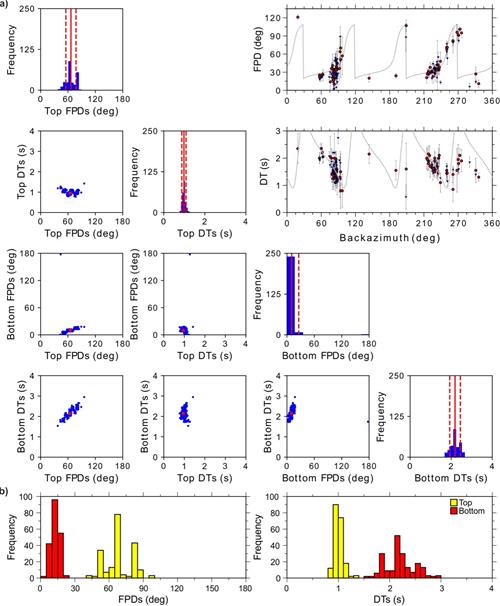Our Ph.D. student from the Geophysical Engineering Department Ceyhun Erman and the members of the Seismology Laboratory and Seismology, Seismotectonic and Geodynamics Research Group (Prof. Dr. Seda Yolsal-Çevikbilen, Doç. Dr. Tuna Eken, Derya Keleş, and Prof. Dr. Tuncay Taymaz), and Prof. Dr. Frederik Tilmann from Deutsches GeoForschungsZentrum (GFZ) Potsdam, Germany have published their recent findings on the complex deformations in the lithosphere and asthenosphere beneath the western Anatolia and Eastern Aegean in the Journal of Geophysical Research–Solid Earth on November 2022.
Our Ph.D. student from the Geophysical Engineering Department Ceyhun Erman and the members of the Seismology Laboratory and Seismology, Seismotectonic and Geodynamics Research Group (Prof. Dr. Seda Yolsal-Çevikbilen, Doç. Dr. Tuna Eken, Derya Keleş, and Prof. Dr. Tuncay Taymaz), and Prof. Dr. Frederik Tilmann from Deutsches GeoForschungsZentrum (GFZ) Potsdam, Germany have published their recent findings on the complex deformations in the lithosphere and asthenosphere beneath the western Anatolia and Eastern Aegean in the Journal of Geophysical Research–Solid Earth on November 2022.
Seismological constrains on uppermost mantle structures provide essential information for better understanding of the geodynamic processes that have shaped the current deformation in complex tectonic regions (e.g., Eastern Mediterranean). To investigate the seismic anisotropy, which is the directional dependence of seismic wave velocities, and its relation to the geodynamical processes in the upper mantle of eastern Aegean and western Anatolia (see Figure), they performed splitting measurements on core-mantle refracted shear waves recorded by 40 permanent broadband seismic stations. They overall estimate NE-SW oriented fast polarization directions, and delay times between 0.65 and 2.2 s. The results imply that the origin of observed seismic anisotropy can be mostly explained by a combined effect of an internal deformation of the mantle lithosphere and asthenosphere. Their findings reveal the presence of two-layer anisotropy outlining complicated structures, primarily in the upper mantle of NW Anatolia associated with the western end of North Anatolian Fault Zone. Future numerical modeling and anisotropy studies should be considered to test these results for further interpretation.
Erman, C., Yolsal-Çevikbilen, S., Eken, T., Tilmann, F., Keleş, D., Taymaz, T. (2022). Constraints on the lithospheric kinematics in the Aegean and western Anatolia unveiled by SKS splitting observations. Journal of Geophysical Research (JGR) – Solid Earth, Vol. 127(12), e2022JB025265. https://doi.org/10.1029/2022JB025265, Received: 26 July 2022, Revised: 18 November 2022, Accepted: 25 November 2022, Available Online: 30 November 2022, Issue Online: 10 December 2022, Issue Published December 2022.
You can reach the paper by following links:
https://agupubs.onlinelibrary.wiley.com/doi/10.1029/2022JB025265
 |
 |
Figure (a) A schematic map of the Eastern Mediterranean with the main suture zones, tectonic structures, and boundaries compiled from Taymaz et al. (1990, 1991, 2004, 2007, 2022), Okay and Tüysüz (1999), Okay (2008), Yolsal-Çevikbilen and Taymaz (2012) and Yolsal-Çevikbilen et al. (2012). Black arrows exhibit relative plate motions with respect to Eurasia (McClusky et al., 2000, 2003; Nocquet, 2012; Reilinger et al., 2006). The rectangular box outlines the study area shown in (b) Gray lines represent the slab contours of Hellenic and Cyprus subduction zones with 20 km interval (see Hayes et al., 2018).
(b) A generic tectonic map of the Aegean region and western Anatolia with major geological structures (Mascle & Martin, 1990; Şaroğlu et al., 1992; Taymaz et al., 1990, 1991, 2004, 2022; Yolsal-Çevikbilen et al., 2014).
(c) Map of the average splitting parameters (black bars) reported by Vinnik et al. (1992), Hatzfeld et al. (2001), Schmid et al. (2004), Evangilidis et al. (2011), Paul et al. (2014), Olive et al. (2014), Confal et al. (2016), Evangelidis (2017), and Kaviris et al. (2018). GPS vectors (red arrows) are shown relative to stable Eurasia, as reported by Nocquet (2012). Abbreviations: ASM: Anaximander Sea Mountains, CTF: Cephalonia Transform Fault, EAFZ: East Anatolian Fault Zone, Ed: Gulf of Edremit, ESM: Eratosthenes Sea Mountains, G: Gulf of Gökova, HB: Herodotus Basin, IAESZ: İzmir-Ankara-Erzincan Suture Zone, LN: Lycian Nappes, MM: Menderes Massif, NAFZ: North Anatolian Fault Zone, NAT: North Aegean Trough, PTF: Paphos Transform Fault, R: Rhodes Island, Si: Simav Graben. |
An example from two layer grid search estimates and final conceptual model. |